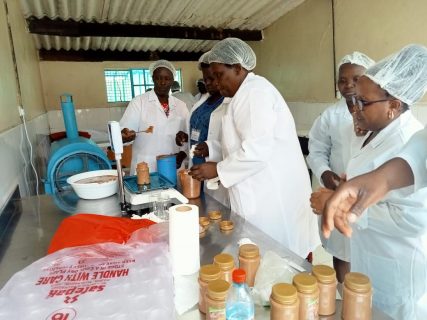Meros just returned from a week in Kenya as part of the JICA SHEP program to work with local consultants to conduct a series of training programs to support entrepreneurs in the peanut butter processing industry. The Smallholder Horticulture Empowerment & Promotion (SHEP) program is a market-oriented agriculture program originally started by the Japan International Cooperation Agency (JICA) in Kenya in 2006 in increase farmer incomes with the philosophy of supporting farmers to “grow to sell”, not just “grow and sell’. The SHEP program has had remarkable success cases in increasing farmer incomes and has been replicated by JICA in other countries in Africa.
Kenya is now in its fourth cycle of JICA SHEP programs. In 2021 JICA SHEP initiated a new pilot project to support micro-entrepreneurs in crop processing. Peanut butter production in Homa Bay was chosen for this pilot. This year’s focus was to support the peanut butter micro-entrepreneurs’ efforts to develop a sustainable local industry.
Located in the eastern part of Kenya on the shores of Lake Victoria, Homa Bay is one of the most important groundnut production areas in Kenya. There is an emerging industry of young entrepreneurs who roast, grind, and process groundnuts into peanut butter. The Homa Bay peanut variety is called Homa Bay Red, which has a particularly high oil content and produces a smooth, creamy peanut butter.
However, discussions last year with producers and processors, including local agricultural extension workers, revealed that major hurdle for these young entrepreneurs was the process of obtaining food safety certification.
To grow their businesses, these entrepreneurs aim to sell their peanut butter to wholesalers who will be able to place their products into retail supermarkets. However, food safety certification has become a minimum requirement for wholesaling to supermarkets and other retail chains and is an unavoidable step for expanding into the channel. The challenge is that preparation for this certification requires internal plant maintenance, HACCP plans, lot control books, and various other types of record keeping that many of the entrepreneurs are not yet prepared for.
To help the micro-entrepreneurs get ready for food safety certification, we worked with local Kenyan counterparts, local agricultural extension agents, professional organizations, and Tom Mboya National University to conduct two intensive 3-day food safety seminars for the entrepreneurs in March and May.


The first session in March covered food safety basics and product standards for peanut butter, labeling and packaging, as well as GMP (Good Manufacturing Practice). This included guidance on choosing proper locations and premises for the processing, proper clothing while in the processing facilities, proper heating and cooling, the appropriate techniques and machinery for accurate weighing and measurement, as well as proper standards and techniques for cleaning. The participants could all practice their skills on university equipment.
The second session in May was more in-depth and practical, inviting a food safety certification organization to present on the next steps. The seminar focused on group work to review how to use a grain moisture meter, how to keep records and lot numbers, how to compile company rules and procedures, how to analyze risks in accordance with HACCP and create a HACCP plan for the company, as well as review the documents and procedures required to apply for food safety certification.




The participants in these workshops had all been nominated by the local agricultural extension staff as being among the best and brightest entrepreneurs in the region. Despite the tough 3-day course schedule, the peanut butter entrepreneurs all actively participated and had excellent, positive attitudes.
Under the slogan “Food Safety First, Money Later,” several of the participating processors have already begun preparing to apply for food safety certification this summer.
In future seminars, we plan to further address the issue of aflatoxin (toxic mold that can easily develop on some seeds and nuts), which is a major risk to peanuts, as well as business development topics such as ensuring a stable peanut supply and creating market development plans.









You must be logged in to post a comment.